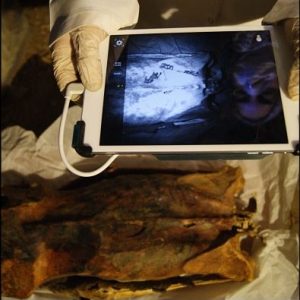
PHOTO: archaeology.org
Mummies in museums normally lay encased in their wrappings. Their bodies are never looked at because, usually, there’s no reason to. Not so for one mummy from the Valley of the Kings, observed by bioarchaeologist Anne Austen of Stanford University. The remains of the woman have been specifically placed to be from Dier el-Medina, a city in Egypt were most of the artists who worked on the tombs in the Valley of the Kings were thought to have lived. These artists included woodworkers, stonemasons, painters, gold and silversmiths, and hundreds of other trades and crafts popular in Egypt at the time, all working to create a comfortable afterlife for the god-kings who rested in the tombs just a few miles away in the blazing desert.
When the archaeologists in charge of the mummified remains decided to remove the mummy’s wrappings, they found quite the surprise lurking underneath the linen. The woman’s body is covered in over 30 tattoos. What’s most extraordinary about this find, perhaps, is that they are picture tattoos. Tattoos are not uncommon to find on mummies from Egypt, but usually these tattoos are comprised of dots and lines. This woman’s body was covered in tattoos made up of pictures like lotus blossoms on her hips, cows on her arm, baboons on her neck, and Wadjet eyes on her neck, shoulders, and back. All of these are symbols associated with the Egyptian goddess, Hathor.
“Any angle that you look at this woman, you see a pair of divine eyes looking back at you.” – Anne Austen
Some of the tattoos are more faded than others, suggesting that they were accumulated over this woman’s lifetime. These tattoos were found and photographed using an infra-red sensor.
3,000 years ago, at the time this woman lived, the Greeks were still in their dark ages, the period in which the events of the Iliad and Odyssey take place. Sparta was just being founded. It’s a period in Egypt’s history that is referred to as the “Third Intermediate Period”. It’s the third to last period of ancient Egyptian history. Egypt was thrown into decline and social instability. The country was locked in a power struggle between Pharoahs and the High Priests of Amun. By this time, the pyramids had been built, broken into, cleared out, and Egyptian Pharoahs were being buried in the less obvious underground tombs in the Valley of the Kings, their tombs disguised in the valley so that grave robbers couldn’t find them.

PHOTO: landofpyramids.org
What was the significance of the woman’s tattoos? Why would she pick tattoos associated with the goddess Hathor? Well, to know that, we have to know who Hathor was. Hathor was the Egyptian goddess of love, feminine graces, and fertility. She is often depicted as welcoming the dead into the next life, and is commonly depicted as a cow-goddess. Perhaps this young woman chose objects associated with this goddess for her tattoos in hopes that she would be recognized by the goddess in the afterlife and welcomed in. But, what’s more likely is that she hoped that the tattoos would grant her the goddesses’ favor in childbearing. It’s quite likely that depictions of items commonly associated with the goddess of love and fertility were even chosen to make her more attractive to members of the opposite sex. They are, as an afterthought, quite sexual in nature, considering they were put in places like her hipbones, neck, and back. Maybe she just liked the way they looked. We’ll never know.
No matter the reason for their application, these tattoos are, undeniably, an incredible find. This is one of the first discoveries of mummies with picture tattoos, and certainly the first mummy unearthed in quite awhile to have this many tattoos on her body. It’s certainly an interesting find for archaeologists and gives us a glimpse into what life was really like for ancient Egyptians 3,000 years ago.

